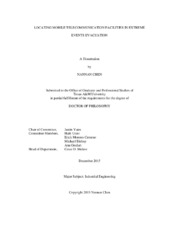| dc.contributor.advisor | Yates, Justin | |
| dc.creator | Chen, Nannan | |
| dc.date.accessioned | 2016-05-04T13:23:25Z | |
| dc.date.available | 2017-12-01T06:36:18Z | |
| dc.date.created | 2015-12 | |
| dc.date.issued | 2015-12-16 | |
| dc.date.submitted | December 2015 | |
| dc.identifier.uri | https://hdl.handle.net/1969.1/156511 | |
| dc.description.abstract | Large regional evacuations caused by severe weather such as hurricane’s and tsunami’s are fraught with complexity, uncertainty and risk. During such events, evacuees have to make decisions on route planning and point-of-destination while emergency managers need to ensure that appropriate personnel and infrastructure are available and capable of facilitating the evacuation. In parallel, the widespread usage of social media and micro-blogs enabled by mobile technology is leading to more dynamic decision-making and real-time communication by evacuees.
This research uses deterministic and simulation techniques to model regional hurricane evacuation. A mixed integer formulation for telecommunication equipment location is used to identify gaps or strains in mobile service and to locate mobile telecommunications equipment to temporarily alleviate system stress. This problem unifies location allocation and routing characteristics with signal interference processing to maximize the number of served users through the evacuation. A Greedy Randomized Adaptive Search Procedure (GRASP) metaheuristic and a Lagrangian Relaxation-based heuristic are used to solve larger problem instances.
Agent-based simulation modeling is used to investigate the reliability, robustness and effectiveness of telecommunications equipment location given the inherent diversity and uncertainty of individual decision-making during evacuation. The agent-based simulation adopts Fuzzy Cognitive Maps to model individual evacuation decision-making that dynamically integrates external information (e.g., physical environment, interpersonal communication) and internal data (e.g., historical empirical, demographic trends). This research shows how social communication among evacuees positively impacts travel patterns as well as overall evacuation time and the usage of mobile telecommunications equipment. | en |
| dc.format.mimetype | application/pdf | |
| dc.language.iso | en | |
| dc.subject | telecommunication equipment location | en |
| dc.subject | emergency evacuation | en |
| dc.subject | agent-based simulation | en |
| dc.subject | fuzzy cognitive maps | en |
| dc.title | Locating Mobile Telecommunication Facilities in Extreme Events Evacuation | en |
| dc.type | Thesis | en |
| thesis.degree.department | Industrial and Systems Engineering | en |
| thesis.degree.discipline | Industrial Engineering | en |
| thesis.degree.grantor | Texas A & M University | en |
| thesis.degree.name | Doctor of Philosophy | en |
| thesis.degree.level | Doctoral | en |
| dc.contributor.committeeMember | Uster, Halit | |
| dc.contributor.committeeMember | Moreno-Centeno, Erick | |
| dc.contributor.committeeMember | Bishop, Michael | |
| dc.contributor.committeeMember | Goulart, Ana | |
| dc.type.material | text | en |
| dc.date.updated | 2016-05-04T13:23:25Z | |
| local.embargo.terms | 2017-12-01 | |
| local.etdauthor.orcid | 0000-0002-4892-075X | |


